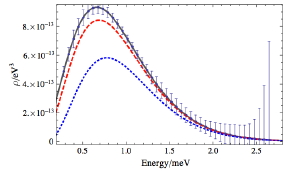Post
Dying Light
31 July 2013
Photons are massless. We know they are massless because particles with mass can’t move at the speed of light. We know that special relativity works, and the speed of light is the same in all frames of reference, and special relativity only works if photons are massless. Except…
What if photons had a tiny mass. If it was small enough, then light could travel at almost the speed of light, and special relativity would almost be true. How confident are we that the photon doesn’t have mass? After all, we once thought neutrinos didn’t have mass and we now know they do have mass.
Just to be clear, we know a lot more about light than we do about neutrinos. Neutrinos are notoriously difficult to detect, while photons are quite easy to observe (you’re probably doing it now!) We’ve conducted tests on light in lots of different ways, and in every experiment the “massless photon” model works. We have no reason to assume that the mass of a photon is anything other than zero.
Still, it is worth testing that assumption. We know that if photons have mass it would have to be very small. There are theoretical models that allow for photon mass. For very small masses these models look very similar to the ones we use (such as Maxwell’s equations and the constant speed of light), but at larger masses they predict effects we would have seen by now.
One of these effects would be seen in the cosmic microwave background. As outlined in a recent paper in Physical Review Letters,1 the cosmic background wouldn’t match a blackbody curve if the photon had mass. (I’ve talked about the blackbody curve before, and you can see the curve in the figure below.)
 Julian Heeck
Julian HeeckThe energy of photons depends upon its color. Photons at the blue end of the spectrum have more energy than photons at the red end of the spectrum. If photons have mass, then they don’t all move at the constant “speed of light,” but instead the speed of light would depend on the wavelength of light. Large wavelength (reddish) light has less energy than short wavelength (bluish) light. This means instead of being a perfect blackbody, the cosmic microwave background would be brighter than expected at long wavelengths and dimmer than expected at short wavelengths. The larger the photon mass, the bigger this effect would be.
The cosmic background matches a blackbody so perfectly that the photon mass can be no larger than a hundredth the mass of an electron. That’s pretty tiny, but other optical experiments require that the photon have a mass no larger than a trillionth of a trillionth of the mass of an electron. That’s a septillionth of an electron mass. So if the cosmic background puts less of a limit on photon mass than other experiments, what’s the big deal?
If the photon has mass, even a septillionth of an electron mass, it is possible that the lightest neutrino has an even smaller mass. We know that neutrinos have mass. There are actually three types of neutrinos, and we know the sum of their masses can be no larger than 2 millionths of an electron mass. But we don’t know what their masses actually are. If the lightest neutrino has a mass even smaller than the photon, then it would be possible for photons to decay into neutrinos.
That would mean photons wouldn’t last forever. Instead they would have a half life. This would have huge cosmological consequences, because it would mean that over billions of light years some of the light would decay into neutrinos. The distant regions of the universe would appear dimmer than they should, and since the brightness of things like supernovae are used to measure distance, the universe would appear larger than it actually is.
But the photons wouldn’t decay equally. Because bluish photons would have a greater speed than reddish photons, the time dilation effect of special relativity would mean that bluish photons would last longer than reddish photons. And that means the light from the cosmic microwave background would again be distorted
You can see this in the image above, where the observed blackbody spectrum (the dots) is plotted against different half-lifes for the photon. (Just as a side note, those error bars are actually 1000 times larger than the actual ones, which would be too small to see on the graph). The lines are plotted for different half-life values.
Based on observation of the cosmic microwave background, the half-life of a photon must be at least three years. That doesn’t seem like a long time, but light travels so fast that time dilation would make them last much longer. In the visible spectrum their effective half-life would be about a quintillion years, or about a billion times longer than the age of the universe.
In other words, we can experimentally demonstrate that if photons have mass, then it is so extremely tiny that it is effectively massless, and if they can decay into neutrinos their average lifetime is so incredibly long that it is effectively forever. So the assumption that the photon is massless and never decays is a good one.
Again, just to be clear, there is absolutely no evidence that photons are anything other than massless, and there are important theoretical reasons to presume photons are massless. But experiments like these are good because they test the limits of our assumptions, and help keep us honest.
Because if we stopped testing our ideas, that really would be a dying of the light.
Heeck, Julian. “How stable is the photon?.” Physical review letters 111.2 (2013): 021801. ↩︎